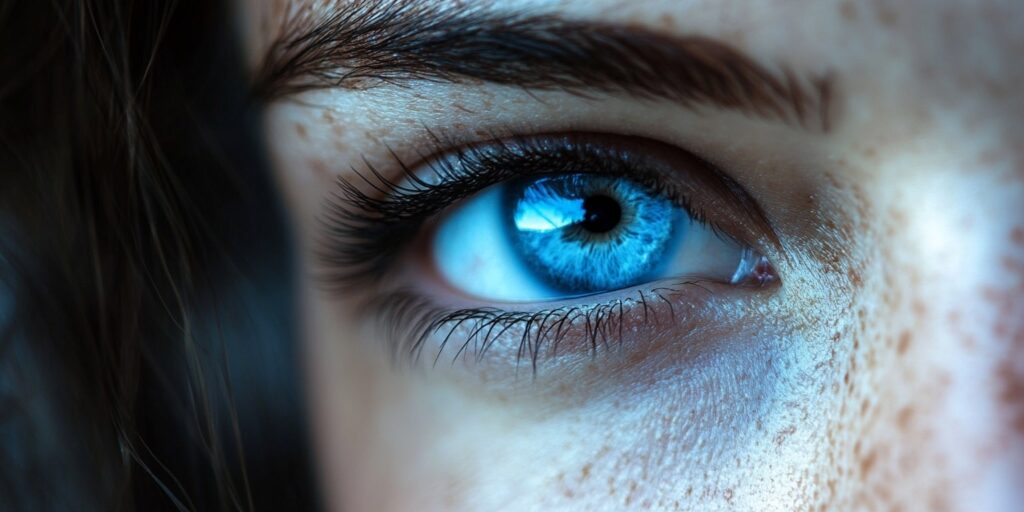blue eyes
Ihr Leitfaden, Informationen und Tipps
The Ultimate Guide to the Enigmatic Beauty of blue Eyes
Blue eyes have long been a source of fascination and admiration across cultures and history. Their striking appearance, often described as captivating and mysterious, sets them apart from other eye colors. But what exactly makes blue eyes so special?
For starters, blue eyes are relatively rare. Only about 8-10% of the world’s population has blue eyes, making them one of the rarest eye colors globally. This rarity contributes to their allure, as many people find the uniqueness of blue eyes particularly attractive. Interestingly, all people with blue eyes share a common ancestor who lived about 6,000 to 10,000 years ago. This ancestor carried a genetic mutation that led to the dilution of brown pigment in the eyes, resulting in the first blue-eyed individuals.
In this comprehensive guide, we’ll explore everything you need to know about blue eyes—from their captivating allure and the science behind their color to essential tips on protecting and enhancing them. We’ll also uncover fascinating myths, discuss the best sunglasses to safeguard your eyes, and offer expert advice on maintaining your eye health. Whether you’re looking to accentuate your blue eyes with fashion tips or protect them with top-quality eyewear like ROLF Spectacles, this guide has you covered.
Ready to dive into the world of blue eyes? Let’s get started.
Key Takeaways of blue eyes
| Topic | Key Takeaways |
|---|---|
| The Science of Blue Eyes | Explore how blue eyes get their color, the genetics behind it, and their rarity. |
| Eye Care Tips | Essential advice on protecting blue eyes, especially given their sensitivity to light. |
| Protection from UV Damage | Learn why blue eyes are more vulnerable to UV rays and discover the best sunglasses, including ROLF Spectacles. |
| Fashion Tips and more | Fashion tips and accessories to make your eyes stand out. |
| Fascinating Myths and Facts | Debunk common myths and uncover intriguing facts about blue eyes. |
| Eye Health | Focus on the unique health needs of blue-eyed individuals, including common conditions and prevention. |
The Science Behind Blue Eyes
Blue eyes have captivated people for centuries, but the science behind their mesmerizing color is equally fascinating. Unlike brown or hazel eyes, blue eyes don’t actually contain blue pigment. Instead, their color is the result of a complex interaction between light and the structure of the iris.
How Blue Eyes Get Their Color
The color of your eyes is primarily determined by the amount of melanin in the iris, which is the colored part of the eye. Melanin is a pigment that absorbs light, and the more melanin you have, the darker your eyes will be. In the case of blue eyes, there is very little melanin present. This lack of pigment causes light to scatter as it enters the eye, a phenomenon known as Rayleigh scattering—the same effect that makes the sky appear blue.
Interestingly, all blue-eyed people share a common ancestor who lived about 6,000 to 10,000 years ago. A genetic mutation in the OCA2 gene, which affects melanin production, is responsible for this eye color. This mutation doesn’t „create“ blue eyes directly but rather limits the amount of melanin produced in the iris, leading to the blue appearance.
Rarity of Blue Eyes in the Global Population
Blue eyes are relatively rare, found in about 8-10% of the global population. This rarity adds to their mystique and desirability. These eyes are most commonly found in people of European descent, particularly in countries like Finland, Estonia, and Ireland, where the percentage of blue-eyed individuals can be as high as 90%. However, outside of Europe, blue eyes are much less common, making them even more unique and sought after in other parts of the world.
The rarity and unique genetic origin of blue eyes contribute to their special place in human history and culture. Their appearance is not just a simple trait but a result of thousands of years of genetic evolution and migration.
Caring for Your Blue Eyes
Blue eyes are undoubtedly beautiful, but they also require special care due to their unique characteristics. One of the most significant aspects of blue eyes is their increased sensitivity to light, which stems from the lower levels of melanin in the iris. This sensitivity means that blue-eyed individuals need to be particularly mindful of protecting their eyes from environmental factors that can cause strain or damage.
The Sensitivity of Blue Eyes
Because blue eyes have less melanin, they allow more light to enter the eye. This can be both a blessing and a curse. On the positive side, people with those eyes often have better night vision than those with darker eyes because their eyes can capture more light in low-light conditions. However, this also makes blue eyes more susceptible to glare and bright sunlight, which can lead to discomfort or even long-term damage if not properly protected.
For example, studies have shown that people with lighter-colored eyes are more prone to developing certain eye conditions, such as macular degeneration and cataracts, later in life. This increased risk makes it essential for blue-eyed individuals to take proactive steps in protecting their eyes.
Importance of Regular Eye Exams
Given the heightened sensitivity of blue eyes, regular eye exams are crucial. These check-ups allow eye care professionals to monitor your eye health closely and catch any potential issues early. For blue-eyed individuals, it’s particularly important to have exams that include a thorough check of the retina, where conditions like macular degeneration can develop.
It’s recommended that adults with blue eyes have an eye exam at least once every two years, and annually if there are any signs of eye strain, vision changes, or if you spend a lot of time outdoors in bright conditions. Children with blue eyes should also have regular eye exams to ensure their eyes are developing properly and to address any issues that could affect their long-term vision.
Taking these steps will not only protect your eyesight but also help maintain the health and beauty of your blue eyes for years to come.
Back
Greyblue
Ravi
Sapphire Blue
„Enhance and protect the natural allure of your blue eyes.“
Protecting Blue Eyes from UV Damage
Blue eyes, with their reduced melanin levels, are particularly vulnerable to the harmful effects of ultraviolet (UV) radiation. While UV exposure is a concern for everyone, those with blue eyes need to take extra precautions to protect their vision and prevent long-term damage.
Why UV Protection Is Crucial for Blue Eyes
Melanin, the pigment responsible for eye color, also plays a critical role in protecting the eyes from UV radiation. Since blue eyes have less melanin compared to darker eyes, they are less effective at filtering out UV rays. This makes blue-eyed individuals more susceptible to UV-related eye conditions, such as photokeratitis (a painful condition similar to a sunburn on the cornea), cataracts, and macular degeneration.
A study published in the journal Ophthalmology found that people with lighter eye colors, including blue, are at a higher risk of developing age-related macular degeneration (AMD), a leading cause of vision loss in older adults. The study highlights the importance of UV protection for maintaining long-term eye health, especially for those with blue eyes.
Best Sunglasses for Blue Eyes
Wearing sunglasses is one of the most effective ways to protect your blue eyes from UV damage. When choosing sunglasses, it’s essential to look for a pair that offers 100% UV protection, meaning they block both UVA and UVB rays. Additionally, polarized lenses are an excellent choice for reducing glare, which can be particularly bothersome for blue-eyed individuals.
ROLF Spectacles, known for their high-quality and stylish eyewear, offer sunglasses that not only provide full UV protection but also enhance your natural eye color. Their sunglasses are designed with premium materials and advanced lens technology to ensure your blue eyes are well-protected while looking effortlessly chic. Whether you’re spending a day at the beach or driving under bright sunlight, the right sunglasses can make all the difference.
When selecting the lens tint, consider going for shades like gray or brown, which offer good color contrast without altering the natural colors too much. These tints are perfect for everyday wear and will help protect your eyes without sacrificing style.
By prioritizing UV protection and choosing the right sunglasses, you can enjoy the beauty of your blue eyes while keeping them safe from potential damage.
Fashion Tips for Blue Eyes
Blue eyes are often considered one of the most striking and desirable eye colors, thanks to their clarity, brightness, and the captivating way they can reflect light. Whether you naturally have blue eyes or want to make the most of their unique beauty, there are several techniques and tips you can use to enhance their appearance.
Complementary Fashion Choices
One of the most effective ways to enhance blue eyes is by choosing clothing and accessories in colors that complement and intensify their hue. Certain colors can make blue eyes appear even more vibrant:
- Shades of Blue: Wearing blue clothing, especially in shades that match or contrast with your eye color, can create a harmonious and striking look.
- Earth Tones: Colors like warm browns, taupe, and camel can create a beautiful contrast with blue eyes, making them stand out.
- White and Black: These classic colors can provide a stark contrast that highlights the brightness of blue eyes.
- Jewel Tones: Deep greens, purples, and rich jewel tones can create a dramatic effect, making blue eyes appear more vivid.
Makeup Tips for Blue Eyes
Makeup can be a powerful tool for enhancing blue eyes, drawing attention to their natural beauty:
- Eyeshadow Colors: Warm, earthy tones like copper, bronze, peach, and terracotta are perfect for making blue eyes pop. These colors create a striking contrast against the coolness of blue eyes. Additionally, shades of lavender or soft pink can bring out the lighter tones in blue eyes.
- Eyeliner Choices: Brown or bronze eyeliner can add warmth and depth, while navy or gray eyeliner can complement the coolness of blue eyes without being too harsh. For a bold look, a dark black eyeliner can create a dramatic contrast.
- Mascara: Black mascara is a go-to for most, but for a softer, more natural look, brown mascara can complement blue eyes beautifully, especially during the day.
Hair Color Considerations
Your hair color can also influence how your blue eyes are perceived:
- Blonde or Light Brown Hair: These lighter hair colors can enhance the brightness and clarity of blue eyes, making them appear more vivid.
- Dark Brown or Black Hair: Dark hair creates a striking contrast with blue eyes, making them stand out dramatically. This combination is often considered both elegant and mysterious.
- Red Hair: The warm tones of red hair can create a beautiful contrast with blue eyes, highlighting their cool, icy tones.
Choosing the Right Eyewear
Eyewear can be another powerful way to enhance blue eyes. Whether you need prescription glasses or just want to make a fashion statement with sunglasses, consider the following tips:
- Frame Colors: Frames in colors like tortoiseshell, black, navy, or deep green can create a flattering contrast with blue eyes. Clear or light-colored frames can also work well, allowing your eyes to take center stage.
- Lens Tint: If you wear sunglasses, consider lenses in gray or brown tones, which can complement the natural color of your eyes while providing necessary UV protection.
More Tips in our Blog about: What glasses suits me?
Keeping Your Blue Eyes Healthy and Bright
Finally, maintaining the health of your blue eyes is crucial for keeping them looking their best. Proper hydration, a diet rich in eye-healthy nutrients (like those discussed earlier), and regular eye care routines, such as using lubricating eye drops, can all contribute to the overall brightness and clarity of your eyes.
By combining these fashion, makeup, and health tips, you can enhance the natural beauty of your blue eyes, making them even more captivating and vibrant. Whether you’re dressing up for a special occasion or just want to look your best every day, these strategies will help you showcase your blue eyes to their full potential.
The Role of Nutrition in Blue Eye Health
While blue eyes are undeniably beautiful, maintaining their health and clarity goes beyond just external protection like sunglasses. Nutrition plays a crucial role in keeping your eyes healthy and preventing conditions that could affect your vision over time. A diet rich in certain nutrients can help protect your blue eyes from age-related issues, enhance their natural radiance, and support overall eye health.
Key Nutrients for Blue Eye Health
Lutein and Zeaxanthin: These are antioxidants found in high concentrations in the macula, the part of the retina responsible for central vision. They help filter harmful blue light and protect the eyes from oxidative stress. Foods rich in lutein and zeaxanthin include leafy greens like spinach, kale, and collard greens, as well as eggs and corn.
Vitamin C: This powerful antioxidant supports the health of blood vessels in the eyes and helps protect against cataracts. Citrus fruits like oranges, grapefruits, and lemons are excellent sources of vitamin C, as are strawberries, bell peppers, and broccoli.
Vitamin E: Another antioxidant that protects the eyes from oxidative damage, vitamin E is crucial for maintaining eye health. Nuts, seeds, and green leafy vegetables are rich in vitamin E. Almonds, sunflower seeds, and spinach are particularly good sources.
Omega-3 Fatty Acids: Essential for maintaining the health of the retina, omega-3 fatty acids also help prevent dry eyes—a common issue for many people, especially those with blue eyes. Fatty fish like salmon, mackerel, and sardines are high in omega-3s, as are flaxseeds, chia seeds, and walnuts.
Zinc: This mineral plays a vital role in transporting vitamin A from the liver to the retina, where it helps produce melanin—the protective pigment in the eyes. Zinc is found in foods like oysters, beef, pumpkin seeds, and chickpeas.
Foods to Include in Your Diet
Incorporating a variety of these nutrient-rich foods into your diet can significantly benefit your eye health:
- Leafy Greens: Spinach, kale, and collard greens are packed with lutein and zeaxanthin.
- Fish: Salmon, tuna, and other oily fish are excellent sources of omega-3 fatty acids.
- Citrus Fruits: Oranges, grapefruits, and lemons provide a healthy dose of vitamin C.
- Nuts and Seeds: Almonds, sunflower seeds, and flaxseeds offer vitamin E and omega-3s.
- Colorful Vegetables: Carrots, sweet potatoes, and bell peppers are rich in vitamins A and C.
Hydration and Eye Health
Staying hydrated is also crucial for maintaining healthy eyes. Dehydration can lead to dry eyes, which may cause discomfort and increase sensitivity to light—a common issue for those with blue eyes. Make sure to drink plenty of water throughout the day, and consider consuming water-rich foods like cucumbers, watermelon, and oranges to help maintain optimal hydration levels.
By paying attention to your diet and ensuring you get enough of these essential nutrients, you can support your blue eyes‘ health and keep them looking vibrant and clear for years to come.

How to Care for Blue Eyes During Different Seasons
Blue eyes, with their heightened sensitivity to light, require special attention throughout the year. Different seasons bring various challenges, from intense sunlight in the summer to harsh glare in the winter. By tailoring your eye care routine to the changing seasons, you can ensure that your blue eyes remain healthy and comfortable year-round.
Summer Eye Care Tips
Summer is a time of bright sunlight and longer days, which can be particularly challenging for those with blue eyes. The increased UV exposure, combined with the glare from water, sand, and other reflective surfaces, can cause significant discomfort and potential damage.
Sunglasses: Always wear sunglasses with 100% UV protection when outdoors. Opt for polarized lenses to reduce glare, especially if you spend time near water or driving. As mentioned earlier, ROLF Spectacles offers stylish options that provide excellent protection.
Wide-Brimmed Hats: In addition to sunglasses, wearing a wide-brimmed hat can provide extra shade and further reduce your eyes‘ exposure to direct sunlight.
Stay Hydrated: The heat can lead to dry eyes, which is uncomfortable and can exacerbate light sensitivity. Drink plenty of water and consider using lubricating eye drops to keep your eyes moist and comfortable.
Winter Eye Care Tips
Winter might not seem as harsh on the eyes as summer, but it comes with its own set of challenges, particularly for blue-eyed individuals. Snow and ice reflect a significant amount of UV light, which can be as intense as summer sun exposure.
Ski Goggles or Sunglasses: When participating in winter sports or spending time outdoors, it’s crucial to wear UV-protective eyewear. Ski goggles with UV protection and anti-fogging features are ideal for protecting your eyes from both UV rays and cold wind.
Moisturize: Cold, dry air can lead to dry eyes, which may cause irritation and discomfort. Use a humidifier indoors to maintain moisture levels in the air, and apply lubricating eye drops as needed.
Watch Out for Glare: Snow glare can be blinding, especially on bright, sunny days. Polarized sunglasses or goggles are your best defense against this winter hazard.
By adjusting your eye care routine according to the season, you can protect your blue eyes from the elements and ensure they remain comfortable and healthy throughout the year.
Celebrities with Blue Eyes
Blue-eyed celebrities have left an indelible mark on Hollywood and beyond, captivating audiences with their talent and unforgettable gaze. Here’s a look at some of the most iconic figures whose eye color has become a defining feature of their allure.
1. Paul Newman
Paul Newman, one of Hollywood’s most beloved actors, was famous for his intense, piercing gaze. His eyes became a symbol of his charm and added depth to his performances in classics like Cool Hand Luke and Butch Cassidy and the Sundance Kid. Newman’s eyes were so iconic that they became a signature part of his public image.
2. Elizabeth Taylor
Elizabeth Taylor’s eyes were legendary, often described as having a unique violet hue that set her apart from other stars. Her mesmerizing gaze added to her mystique and was especially highlighted in her role as Cleopatra, where dramatic makeup accentuated her striking appearance.
3. Frank Sinatra
Known as „Ol‘ Blue Eyes,“ Frank Sinatra’s gaze became almost as famous as his voice. His eyes contributed significantly to his image as a suave and charismatic performer, making him a beloved figure in both music and film.
4. Bradley Cooper
Bradley Cooper’s intense stare has played a significant role in many of his performances, adding emotional depth and intensity to his characters. Whether in dramas like Silver Linings Playbook or action films like American Sniper, his eyes have helped cement his status as a leading man in Hollywood.
5. Megan Fox
Megan Fox is known for her striking appearance, with her gaze being one of her most defining features. Her icy, intense look has been showcased in films like Transformers and Jennifer’s Body, making her a standout in the industry.
6. Chris Hemsworth
Chris Hemsworth, best known as Thor, has a powerful on-screen presence, with his gaze playing a key role in his portrayal of the Norse god. His eyes, combined with his commanding physique, make him one of the most recognizable faces in action cinema.
7. Taylor Swift
Taylor Swift’s bright eyes are one of her most recognizable features, often highlighted in her music videos and album covers. Her gaze adds to her ethereal and romantic image, contributing to her widespread appeal as a global music superstar.
8. Zac Efron
Zac Efron’s gaze has been a defining feature since his breakout role in High School Musical. His eyes, along with his charm, have helped him transition from teen star to a leading man in Hollywood.
9. Cameron Diaz
Cameron Diaz is known for her bright, sunny appearance, with her eyes perfectly complementing her California-girl image. Whether in romantic comedies or action films, her gaze adds to her approachable and fun-loving persona.
10. Henry Cavill
Henry Cavill’s striking eyes add to his commanding presence as Superman. His gaze helps convey both the strength and vulnerability of the iconic character, making him one of the most memorable actors to take on the role.
These celebrities have not only achieved fame for their talents but also for their unforgettable gazes, which have become a significant part of their public personas. Whether through film, music, or fashion, their eyes continue to captivate and inspire fans around the world.


